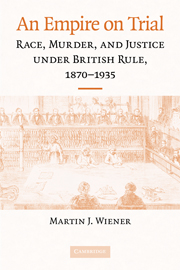Book contents
- Frontmatter
- Contents
- Preface
- Acknowledgments
- AN EMPIRE ON TRIAL
- Introduction
- 1 On the High Seas
- 2 Queensland, 1869–1889
- 3 Fiji, 1875–1885
- 4 Trinidad and the Bahamas, 1886–1897
- 5 India: The Setting
- 6 India: In the Legal Arena, 1889–1922
- 7 Kenya, 1905–1934
- 8 British Honduras, 1934
- Conclusion
- Bibliography
- Index
8 - British Honduras, 1934
Published online by Cambridge University Press: 05 June 2012
- Frontmatter
- Contents
- Preface
- Acknowledgments
- AN EMPIRE ON TRIAL
- Introduction
- 1 On the High Seas
- 2 Queensland, 1869–1889
- 3 Fiji, 1875–1885
- 4 Trinidad and the Bahamas, 1886–1897
- 5 India: The Setting
- 6 India: In the Legal Arena, 1889–1922
- 7 Kenya, 1905–1934
- 8 British Honduras, 1934
- Conclusion
- Bibliography
- Index
Summary
In the Colony men of every race are on an equal footing politically and before the law, and … the poorest black man has his rights as sedulously protected as the richest white man.
Report of the British Honduras Commission of Enquiry following the “Ex-Servicemen's Riot” of 1919A few months before Helen Selwyn had her workers whipped, another fatal encounter took place on the other side of the world in the colony of British Honduras. A lumber mill owner from Alabama, Thurman Eugene Gantt, also seeking recovery of stolen goods, searched the house of a black employee and found nothing. When the man taunted him, he shot him to death.
A small territory in Central America, British Honduras – today the state of Belize, like the Bahamas a major tourist destination – was in 1934 extremely poor, heavily dependent upon the mahogany lumber industry. Like the Bahamas, it was one of the first British colonies. British settlement began in the 1650s, and although Spain continued to dispute ownership down to the end of its Empire in the Americas, the colony was under continuous British control from that time forward, remaining, however, perhaps even more than the Bahamas, a backwater of Empire. In 1934 its economy was almost in shambles, suffering not only from the world depression but also from the aftereffects of a devastating hurricane in September 1931, which practically razed Belize City.
- Type
- Chapter
- Information
- An Empire on TrialRace, Murder, and Justice under British Rule, 1870–1935, pp. 222 - 229Publisher: Cambridge University PressPrint publication year: 2008



